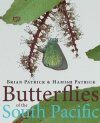Field / Identification Guide
By: Brian Patrick(Author), Hamish Patrick(Author)
240 pages, colour photos, 1 colour map
![Butterflies of the South Pacific Butterflies of the South Pacific]()
Click to have a closer look
About this book
Contents
Customer reviews
Biography
Related titles
About this book
The South Pacific is a vast expanse of ocean over 50 million km2 with tiny scattered islands and island groups. From Kiribati, Tuvalu and Fiji in the west, to the far-flung Marquesas and Austral Islands in French Polynesia in the east, Butterflies of the South Pacific surveys (and discovers) the butterfly inhabitants of these tropical islands. For completeness, Hawai'i to the north where there are many fewer islands in an otherwise empty ocean is included. To the south and with a much larger land area, lies temperate New Zealand, with a further string of islands reaching into sub-Antarctic waters.
It is easy to misjudge butterflies as fragile flying insects: their distribution across a wild and expansive Pacific Ocean proves otherwise. Long ago they colonised by flight isolated and tiny atolls and they continue to claim new territory. Others came by land bridges when sea levels were lower, to mark out their distribution and perhaps establish new species. More recently, people have made their way into the South Pacific region, and the final chapter considers the impacts of human migration and population growth, and identifies conservation issues.
Contents
1 Vast Ocean, Remote Lands, Fragile Butterflies
2 Papilionidae / Swallowtails
3 Pieridae / Whites
4 Nymphalidae, Nymphalids / Fritillaries, Browns
5 Lychaenidae / Hairstreaks, Coppers, Blues
6 Hesperiidae / Skippers
7 Conservation and Education
Appendices
Customer Reviews
Biography
Brian Patrick is the co-author of several books on natural history and invertebrates, including Wild Dunedin, Wild Central, Wild Fiordland (with Neville Peat) and Butterflies and Moths of New Zealand (with Brian Parkinson). He has worked for the Dept of Conservation, at the Otago Museum and as director of the Alexandra Museum.
Hamish Patrick could not escape butterflies and moths, as Brian's son, and has assisted in the fieldwork for and writing of this book. He is completing his masters at Canterbury University.
Field / Identification Guide
By: Brian Patrick(Author), Hamish Patrick(Author)
240 pages, colour photos, 1 colour map




































